The Types of Teeth We Have and Their Functions
I had the idea for a post about the different kinds of teeth we have a few weeks ago and thought it might be too simple. But then I had a patient that was asking me about the different kinds of teeth and their functions in chewing, so I am going forward with the post. Maybe this is not a very exciting topic, but knowledge of the functions of the different kinds of teeth (collectively known as the dentitition) we have could help patients who are experiencing problems because they are not correctly using them.
Herbivores, Carnivores, and Omnivores
Herbivores have very flat teeth to crush plant matter; carnivores have sharp teeth to tear flesh. The combination of teeth we have are specific for our omnivorous diets. Because we have four different types of teeth, we are called heterodonts. We need different kinds of teeth to handle both plant and animal food. Each tooth type is unique and easy to identify by their position in the mouth and their particular shape. We have the same kinds of teeth in the same locations on the top and bottom arches.
Incisors
The front four teeth are known as incisors. More specifically, the middle two are known as central incisors, and the ones next to them are called lateral incisors. They are somewhat rectangular shaped when viewed from the front and spade-shaped when viewed from the side. Incisors taper toward the incisal edge to allow them to act like scissors to grab and cut food. After they grab and cut food, it is passed to the back teeth for chewing. The upper incisors also support the upper and lower lips and aid in speech for “th”, “v” and “f” sounds. They also play a role in esthetics due to their high visibility. They have one root. They displace the primary incisor teeth at around seven years of age.
Canines
The third tooth from the midline is called the canine, cuspid, or eyetooth. The canines are long and pointed, with a somewhat cylindrical shape. They derive their name from their similarity to the “fangs” of canines (or dogs). They have substantial single roots because they absorb most of the lateral forces of chewing, and are the most helpful with tearing food. In individuals with proper occlusion, the canines should be the only teeth touching when the mandible moves from side to side, which makes the posterior teeth come apart, protecting them from wear. The root is noticeable if you lift up your lip and is known as the canine eminence. The upper canines also play a role in supporting the upper and lower lips and are helpful for full speech articulation. The four incisors and two canines in each arch are collectively known as the anterior teeth. They play a significant role in esthetics. They come in around eleven years of age by displacing the primary canines.
Premolars
The fourth and fifth teeth from the midline are known as the first and second premolars or bicuspids. They have two sharp points; one toward the cheeks and one facing the palate. The points are known as cusps, hence the name bicuspid. The cusps enable piercing and ripping of food like the canines but to a lesser degree. The premolars are the first teeth to have occlusal surfaces that help crush food. They can have one or two roots. They erupt into the mouth by displacing the primary molars anywhere from nine to twelve years of age.
Molars
The large teeth behind the premolars are called molars. The ones directly behind the premolars are called the first molars. They are the largest molars, with the lower ones being slightly larger than the upper ones. The lower first molars can have five cusps, whereas most other molars have four. Although the upper first molars can have an extra vestigial cusp called the cusp of Carrabelli. The broad flat chewing surfaces are ideal for crushing food before swallowing. Typically the upper molars have three roots, whereas the lower molars have two. The molars do not replace any primary teeth. They erupt through the gums behind the primary teeth. It is not unusual for the first molar to come in before the loss of any primary teeth, although they may erupt as late as twelve years of age. The molars behind the first molars are called the second molars, or the twelve-year molars due to the typical age of eruption. They are smaller than the first molars but have a similar function. They are not necessary for speech but play a role in supporting the cheeks. The last molars in the mouth are called the third molars, or wisdom teeth because they come in around the time we reach adulthood. They are the smallest molars and have a high degree of variability in shape and number of roots. The third molars frequently do not form or fail to erupt properly into the mouth. Our jaws have less robust development due to less course and nutrient diets than our ancestors.
Misuse
Improper use of teeth can lead to problems like excessive wear and pain. Inappropriate use of teeth mainly stems from having missing teeth. When teeth are removed, the adjacent teeth have to do more work to chew, resulting in premature wear and pain. In a previous post, I spoke about how missing teeth correlate with shorter lifespans. When all of the molars are missing, the premolars will not be able to masticate adequately, causing wear, pain, mobility, and sometimes loss. Patients with only anterior teeth will find chewing very difficult. They will wear quickly and lose their incisal edge, becoming flattened. The wear may aid in crushing food, but since the roots are not meant for direct up and down forces, discomfort and infections may result. Fractured teeth can lose function, and the extent and location of the fracture determine the extent. Finally, the upper and lower teeth must be in proper alignment for optimal function. You can read my previous article on misaligned teeth here.
Summary
We have sixteen teeth in each arch comprised of four incisors, two canines, four premolars, and six molars. The upper and lower teeth must be in proper alignment for optimal function. Incisors cut food, and the canines tear the food apart if necessary. The premolars start to crush and tear the food apart even more. Finally, the molars complete mastication for adequate swallowing. Missing teeth can hinder proper chewing, which can lead to weaker digestion. Food avoidance can lead to malnutrition in two ways. The first is avoiding foods that contain vital nutrients. Secondly, choosing foods that are easier to chew can be more processed and less nutrient-dense, leading to obesity and other related conditions. If you are missing teeth, or suspect your teeth don’t align properly, or have broken teeth, I suggest a visit to your dentist to have these issues assessed.







